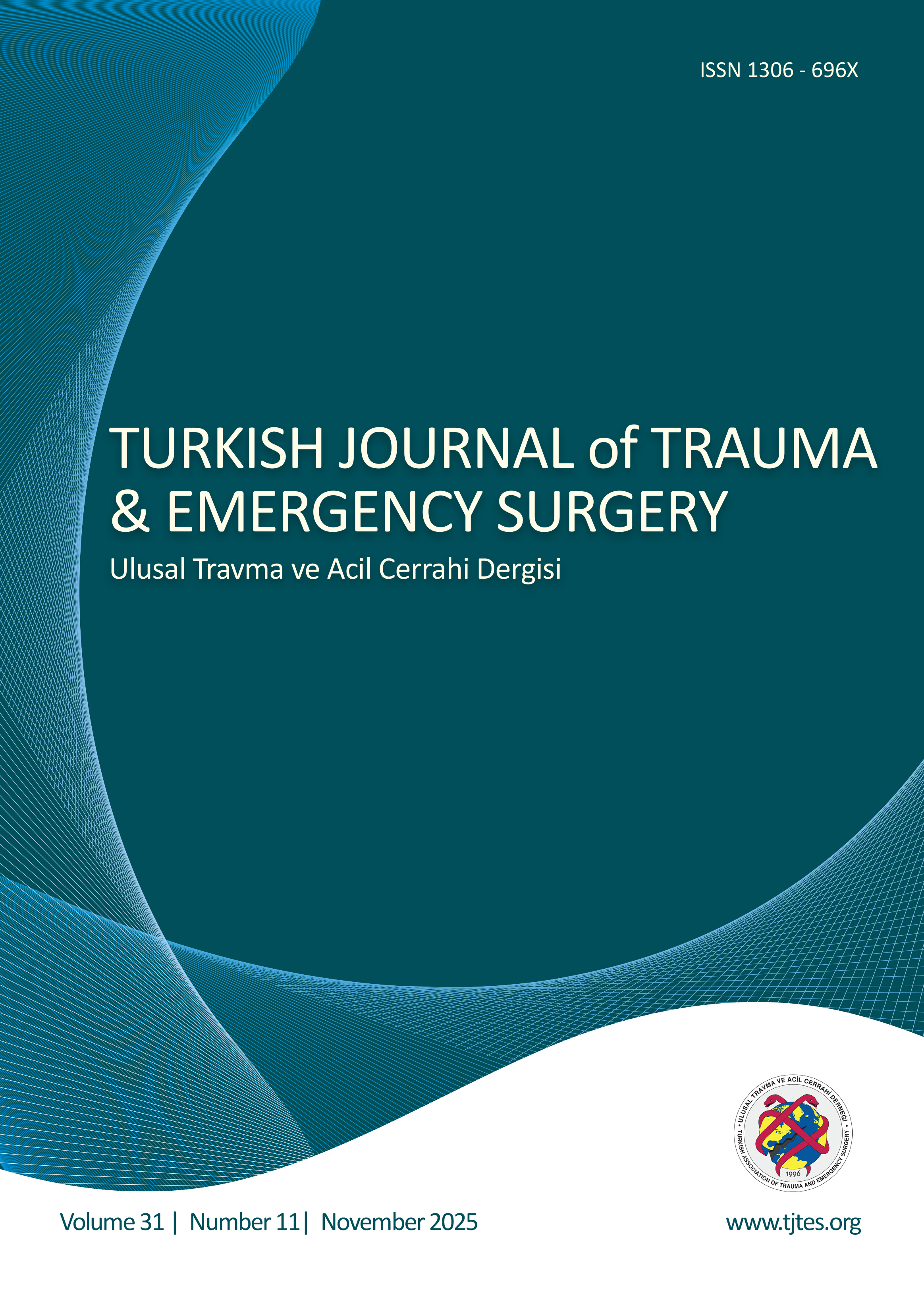Hızlı Arama
Künt Toraks Travmasında Mortaliteye Etki Eden Faktörler
Mustafa Hasbahceci1, Adnan Ozpek1, Fatih Basak1, Mujgan Caliskan1, Behcet Kemal Ener2, Orhan Alimoglu11Ümraniye Eğitim Ve Araştırma Hastanesi Genel Cerrahi Kliniği2Ümraniye Eğitim Ve Araştırma Hastanesi Göğüs Cerrahisi Bölümü
Amaç: Künt toraks travması, travma hastalarında sıklıkla toraks dışı yaralanmalarla birlikte görülmekte fakat mortaliteye etkisi tam olarak bilinmemektedir.
Gereç ve Yöntem: Künt toraks travmalı hastalar, klinik özellikler ve mortaliteye etki eden faktörler açısından değerlendirildi.
Bulgular: Çalışma grubu 76 hastadan (37.2±15 yıl) oluştu. Trafik kazası %63 oranıyla en sık görülen travma sebebiydi. Hastalarda görülen torasik yaralanmalar pnömotoraks (%54), kot fraktürü (%42), hemotoraks (%22) ve akciğer kontüzyonu (%22) olarak tespit edildi. Ekstremite (%46) ve abdomen (%40) toraks dışı travmaların en sık görüldüğü bölgeler idi. Glasgow Koma Skoru, Yaralanma Şiddet Skoru ve Revize Edilmiş Travma Skoru ortalamaları sırası ile 14±2.6, 19±13 ve 7.4±1.5 olarak hesaplandı. Sadece nonoperatif yönetim 37 (%48.7) hastada yeterli olurken, 37 (%48.7) hastada tüp torakostomi ve 2 (%2.6) hastada torakotomi gerekli oldu. Toplam 8 hastada (%10.5) mortalite görüldü. İlk başvuruda 90 mmHgnin düşük sistolik kan basıncı değeri, yüzeyel ve apneik solunum ve travma skorlama sistemi sonuçlarının mortalite üzerinde anlamlı etkisi olduğu tespit edildi (P<0.05).
Sonuç: Künt toraks travmaları toraks dışı sistem yaralanmaları ile genellikle beraber görülmektedir. Toraks patolojisinin tipi ve sayısı ile mortalite arasında bir ilişki gösterilememiştir. Yüzeyel ve apneik solunum, 90 mmHgden düşük sistolik kan basıncı ve travma skorlama sistemi sonuçları mortalite ile yakından ilişkilidir. Nonoperatif yönetim ve tüp torakostomi, tedavi açısından çoğu hastada yeterli olmaktadır.
Anahtar Kelimeler: Torasik travma, künt, travma şiddet indeksleri, mortalite.
Factors Affecting Mortality in Blunt Thoracic Trauma
Mustafa Hasbahceci1, Adnan Ozpek1, Fatih Basak1, Mujgan Caliskan1, Behcet Kemal Ener2, Orhan Alimoglu11Umraniye Education And Research Hospital Dept Of General Surgery2Umraniye Education And Research Hospital Thoracic Surgery
Background: Blunt thoracic trauma is usually associated with extra-thoracic injuries, but effect of blunt thoracic trauma on mortality is not known in.
Methods: Patients with blunt thoracic trauma were evaluated with regard to clinical findings and factors affecting mortality
Results: There were 76 patients (37.2±15 years) in study group. Traffic accidents (63%) were the most common reason. Pneumothorax (54%), rib fracture (42%), hemothorax (22%) and lung contusion (22%) were common thoracic injuries. Extra-thoracic injuries were most commonly seen in extremities (46%) and abdomen (40%). Glasgow Coma, Injury Severity and Revised Trauma Scores were 14±2.6, 19±13 and 7.4±1.5, respectively. Only non-operative management was effective in 37 (48.7%) patients, tube thoracostomy and thoracotomy were performed in 37 (48.7%) and 2 (2.6%) patients, respectively. Mortality rate was 10.5%. Systolic blood pressure lower than 90 mmHg and superficial and apneic respiration at the first admission, and values of trauma scoring systems had significantly related with mortality (p<0.05).
Conclusion: Effect of thoracic trauma on mortality with regard to thoracic pathology is not shown, although it is usually associated with extra-thoracic injuries. There were close relationship between pattern of respiration, values of systolic blood pressure and trauma scoring systems, and mortality. Non-operative management and tube thoracostomy were effective in most of the cases.
Keywords: Thoracic trauma, blunt, trauma severity indices, mortality.
Makale Dili: Türkçe





